Overview
This article serves as an essential guide for project managers seeking to rent a wet vacuum effectively. It begins by outlining the available services and emphasizes the importance of assessing project needs. By exploring the various options and comparing rental services, project managers can make informed decisions that align with their specific cleaning tasks. Evaluating job requirements and understanding equipment specifications are crucial steps in this process.
Conducting thorough research on rental providers is vital to ensure the selection of the right wet vacuum. This guide highlights the need for careful consideration to avoid unnecessary costs while securing reliable equipment. Testimonials from satisfied customers and statistics showcasing the effectiveness of these vacuums further enhance the case for diligent research.
In conclusion, project managers are encouraged to take immediate action by engaging with reputable rental services. By following the outlined steps, they can confidently select the right wet vacuum for their projects, ensuring efficiency and quality in their cleaning tasks.
Key Highlights:
- Evaluate the type of job to determine the size and strength of the wet vacuum needed.
- Measure the surface area to assess if more powerful cleaners or multiple units are required.
- Identify the liquid type to select a device specifically designed for that material.
- Consider the frequency of use to influence rental duration and cost.
- Understand horsepower categories (low: 1-4.5 HP, medium: 5-6 HP, high: 6+ HP) and capacity options (small: 2-6 gallons, medium: 8-14 gallons, large: 14-18 gallons) for effective selection.
- Evaluate available accessories like utility nozzles and squeegees to enhance cleaning efficiency.
- Prioritise key features when renting, including tank capacity, power and suction, portability, and included attachments.
- Conduct online research and seek recommendations to find reliable rental services.
- Compare rental rates, deposit requirements, insurance options, and lease agreement terms to ensure the best value.
- Review the rental agreement carefully and ask questions for clarity before finalising the rental.
Introduction
Navigating the complexities of project management requires a thorough understanding of equipment rentals, particularly when it comes to wet vacuums. This guide offers a comprehensive approach for project managers aiming to efficiently assess their wet vacuum rental needs, explore available options, and identify reliable rental services.
With numerous factors to consider—such as tank capacity, power requirements, and rental terms—how can one ensure they make the most informed decision? This article outlines essential steps and considerations to streamline the rental process, ultimately enhancing project efficiency and effectiveness.
Assess Your Wet Vacuum Rental Needs
To effectively assess your wet cleaning equipment rental needs, start by evaluating where to rent wet vac and the scope of your project. Consider the following factors:
- Type of Job: Determine whether you are addressing a minor spill or a large-scale cleanup. This distinction will assist you in selecting the appropriate size and strength of the wet cleaner required.
- Surface Area: Measure the area that requires cleaning. Larger areas may necessitate more powerful cleaners or multiple units to ensure efficiency.
- Liquid Type: Identify the characteristics of the liquid in question—whether it’s water, chemicals, or other substances—as certain devices are specifically designed for particular materials.
- Frequency of Use: Assess whether this is a one-time use or if you will need the cleaner for ongoing projects. This consideration can significantly influence both the rental duration and overall cost.
- Horsepower and Capacity: Understand the horsepower categories for wet/dry cleaners: low (1-4.5 HP), medium (5-6 HP), and high (6+ HP). Additionally, consider the capacity options: small (2-6 gallons), medium (8-14 gallons), and large (14-18 gallons). This knowledge will aid you in choosing a cleaner that aligns with your specific cleaning needs.
- Accessories: Evaluate the availability of accessories such as utility nozzles and squeegee attachments, which can enhance the cleaner's functionality and efficiency during cleaning tasks.
By clearly defining these needs, you can streamline the leasing process and determine where to rent wet vacs, ensuring you select the right equipment while avoiding unnecessary expenses.
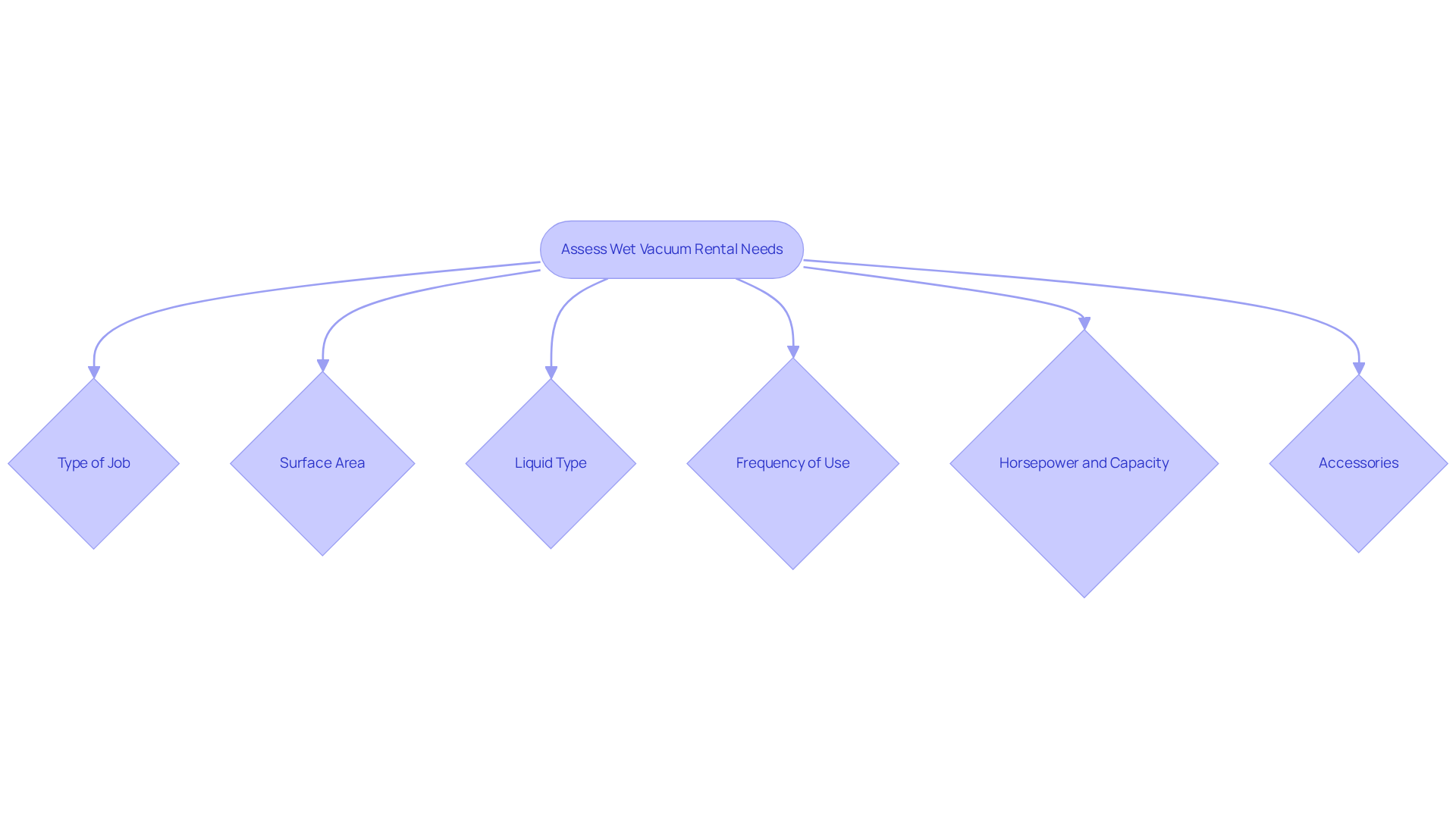
Explore Available Wet Vacuum Options
When considering where to rent wet vac models, several key features should be prioritized to ensure optimal performance for your project needs.
-
Tank Capacity is crucial; wet vacuums typically range from 5 to 16 gallons. Larger tanks minimize the frequency of emptying, making them ideal for extensive cleanups, while smaller tanks enhance portability for quick tasks. For instance, the CRAFTSMAN Wet Dry Vac features a 16-gallon tank, which is well-suited for heavy-duty applications.
-
Power and Suction are equally important. Look for models with a peak horsepower of at least 4 HP, as this is generally recommended for effective debris removal in construction settings. Higher suction power translates to better performance in handling both wet and dry materials. Models like the RIDGID HD1800, which also offers a robust 6.5 peak HP motor, exemplify this requirement.
-
Portability should also be assessed. Evaluate the cleaner's weight and design; models with large wheels and ergonomic handles facilitate easier transport across job sites, which is crucial for frequent movement.
-
Attachments and Accessories can significantly enhance a cleaner's versatility. Ensure the model includes tools suited for various surfaces and debris types, such as crevice tools for tight spaces or squeegees for liquid cleanup.
Including these characteristics in your selection procedure will simplify your leasing experience and guarantee you select a cleaner that fulfills the requirements of your project efficiently, particularly when considering where to rent wet vac. Additionally, consider the importance of HEPA filters, which should be replaced every 6 to 12 months in industrial applications to maintain air quality. By creating a list of potential models that meet these criteria, you can facilitate a more efficient leasing process when considering where to rent wet vac.
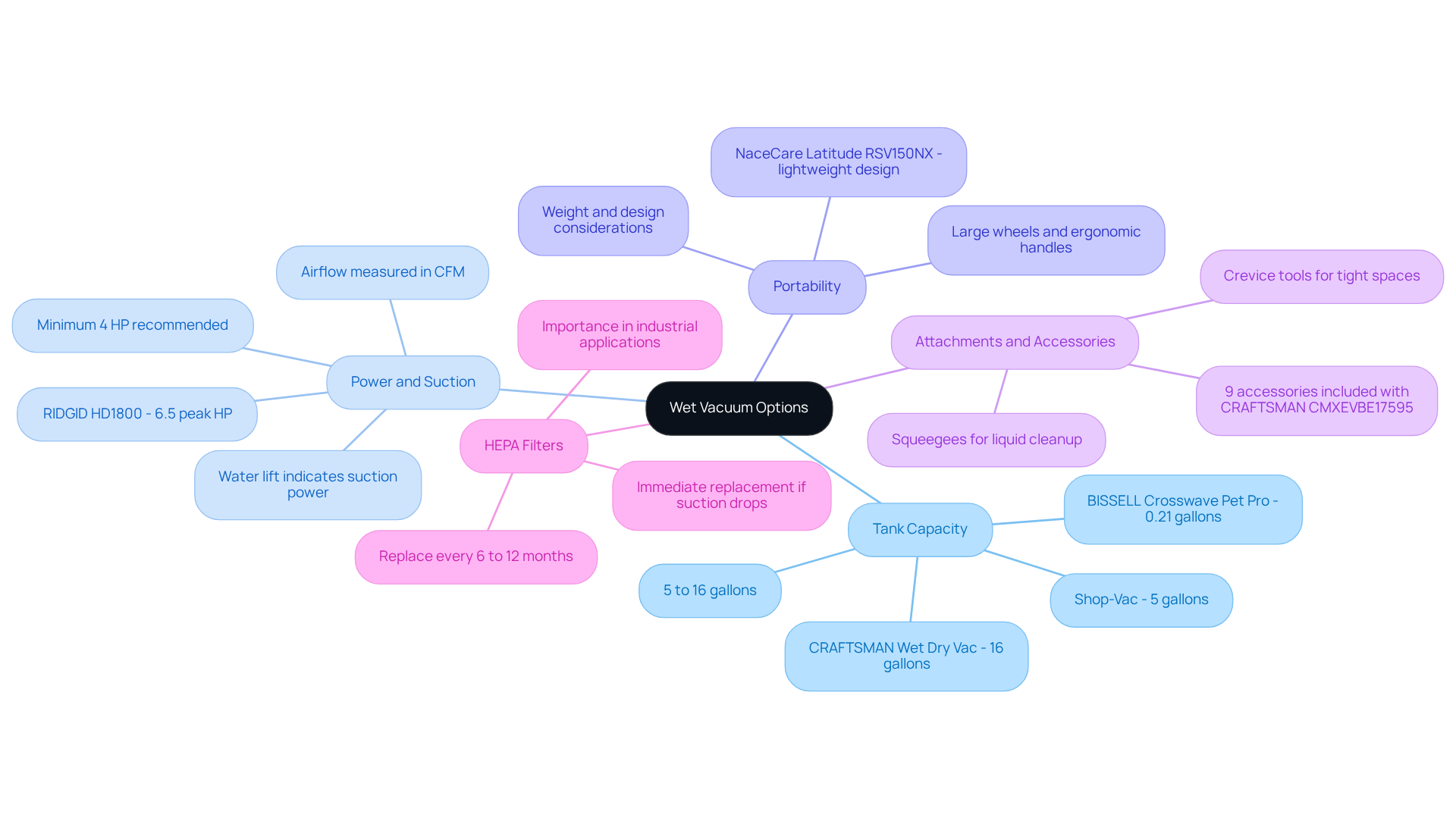
Locate Reliable Rental Services in Your Area
To locate reliable wet vacuum rental services, consider the following strategies:
-
Conduct Online Research: Utilize search engines to identify local rental companies. Pay attention to customer reviews and ratings to evaluate their reliability and quality of assistance. This step is crucial for ensuring that you choose a reputable provider.
-
Seek Recommendations: Engage with colleagues or industry contacts who have previously rented equipment. Personal recommendations can guide you to reliable leasing options, often revealing insights that online reviews may not capture.
-
Explore Leasing Company Websites: Visit the websites of potential leasing firms to review their inventory, leasing policies, and customer support options. Understanding what they offer and how they operate will help you make an informed decision.
Contact local equipment leasing stores to discover where to rent wet vacs, such as established companies like EZ Equipment Rental, which are known for their extensive inventory. Inquire about equipment availability, leasing conditions, and any additional offerings they provide.
After collecting this information, create a list of possible leasing options to aid in comparison and choice in the subsequent steps.
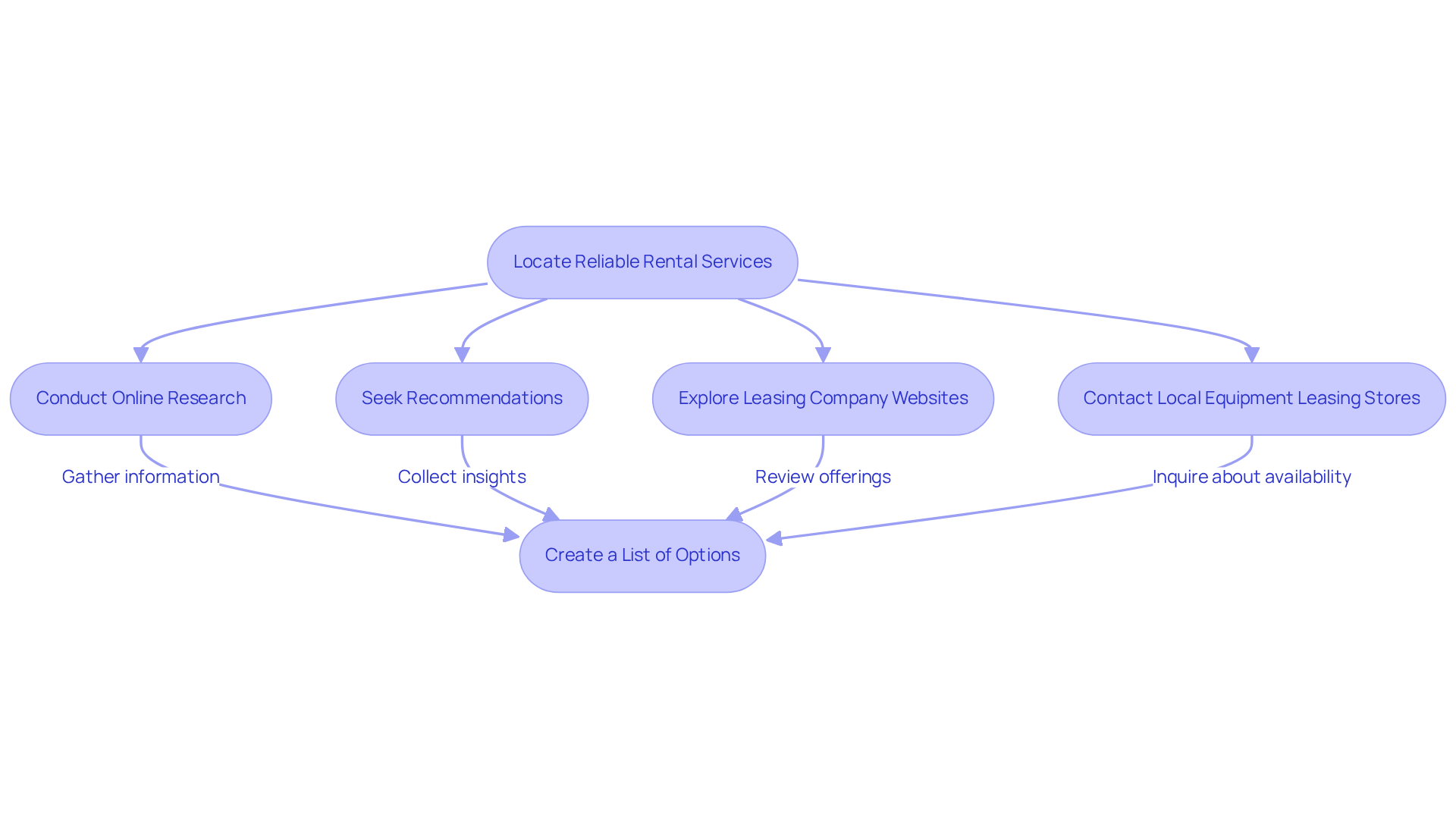
Compare Rental Prices and Terms
When evaluating potential rental services for wet vacuums, it is essential to know where to rent wet vac and conduct a thorough comparison of prices and terms to ensure an informed decision.
Rental Rates: Investigate daily, weekly, and monthly rates. Many firms provide reductions for prolonged leasing durations, significantly lowering expenses.
Deposit Requirements: Familiarize yourself with any upfront costs, including security deposits, which typically range from 10% to 25% of the equipment's replacement value. Understanding these costs is crucial for effective budgeting.
Insurance Options: Inquire whether the leasing provider offers insurance for the equipment and clarify what is covered. This can protect you from unexpected expenses due to damage or loss.
Lease Agreement Terms: Scrutinize the terms and conditions of the lease agreement. Pay attention to late fees, maintenance responsibilities, and return policies, as these can impact your overall experience.
As Nathan Crossley, a software strategist for leasing, emphasizes, "Effective security deposit management represents a crucial intersection of risk management, customer care, and operational efficiency." By carefully analyzing these elements, you can determine the leasing option that offers the greatest value for your requirements. Furthermore, consider instances of project managers who have successfully negotiated advantageous leasing agreements for wet vacuums by determining where to rent wet vac, resulting in substantial savings and improved project efficiency.
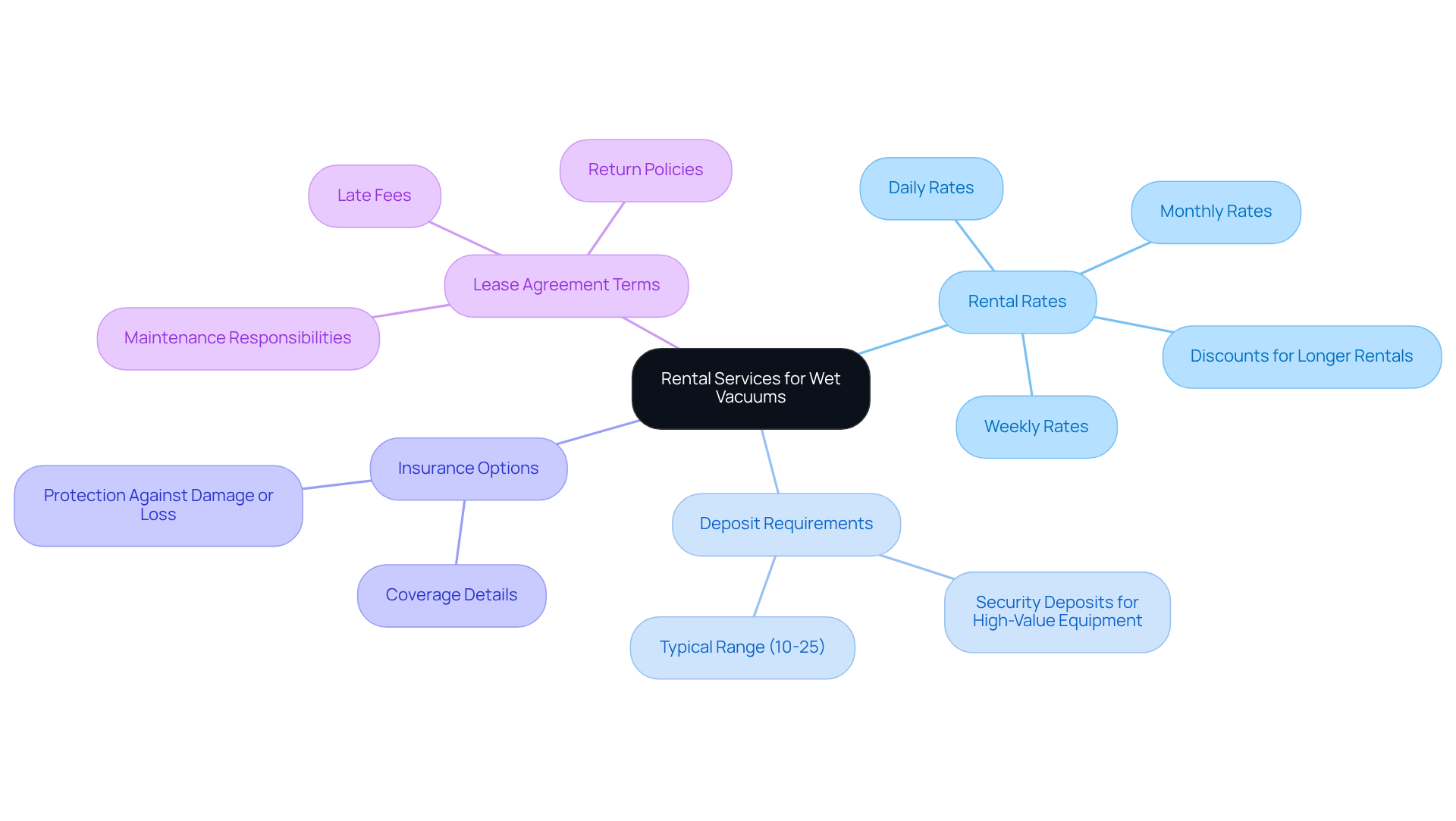
Finalize Your Rental Agreement and Prepare for Pickup
To finalize your rental after selecting a service, follow these essential steps:
- Review the Agreement: Thoroughly examine the rental agreement to confirm that all terms are accurate and meet your expectations. Pay close attention to lease duration, costs, and any additional fees. As a manager, grasping these details is essential; around 60% of tenants who face a late fee encounter two or more late fees within the year, emphasizing the significance of clarity in contracts.
- Ask Questions: If any part of the agreement is unclear, reach out to EZ Equipment Rental for clarification. Understanding every detail is crucial to avoid misunderstandings later. Remember, attentive customer service is vital throughout the leasing process, ensuring you feel secure and supported, especially when acquiring equipment such as boom lifts, excavators, or knowing where to rent wet vacs and wet cleaners that are essential for your projects in the DFW Metroplex.
- Provide Necessary Documentation: Be prepared to show identification and any required documents, such as a business license, to assist with the leasing process.
- Schedule Pickup: Arrange a convenient time for equipment collection, ensuring you have suitable transportation to accommodate the wet cleaner.
As one manager observed, 'Examining the rental agreement carefully can help you avoid unforeseen expenses and guarantee a seamless execution of the task.'
Once these steps are completed, you can confidently pick up your wet vacuum, knowing where to rent wet vac to commence your project.
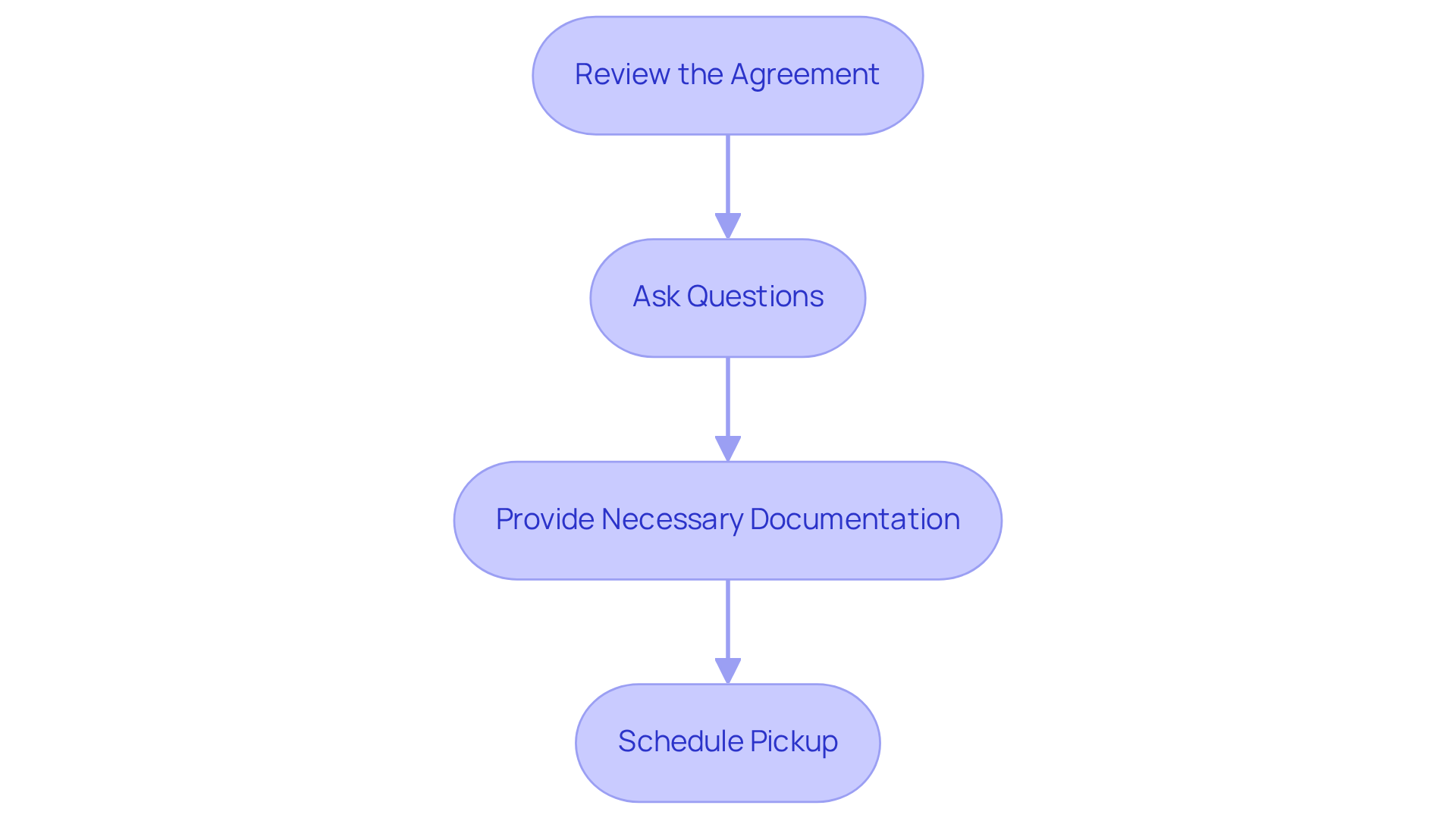
Conclusion
In conclusion, assessing the right wet vacuum rental for a project is not just important; it is essential for achieving efficiency and effectiveness. By thoroughly understanding the specific needs of the job—such as the type of liquid, surface area, and frequency of use—project managers can make informed decisions that lead to successful outcomes. This guide has outlined the critical steps necessary for selecting, comparing, and finalizing a wet vacuum rental agreement, ensuring that every detail is accounted for.
Key considerations discussed include:
- Evaluating essential features of wet vacuums, including tank capacity, power, and portability.
- Locating reliable rental services and comparing prices.
- Understanding rental terms, such as deposits and insurance options, is vital to prevent unexpected costs.
By adhering to these steps, project managers can streamline their rental process, confidently choosing the right equipment that aligns with their project requirements.
Ultimately, the significance of meticulous planning and research in the wet vacuum rental process cannot be overstated. Proactively assessing needs and comparing options not only enhances project efficiency but also contributes to cost-effectiveness. As project managers navigate their rental agreements, they must remain vigilant, ensuring a comprehensive understanding of every aspect of the contract to avoid potential pitfalls. By taking these steps, they will pave the way for a smoother rental experience and successful project completion.
Frequently Asked Questions
How can I assess my wet vacuum rental needs?
To assess your wet vacuum rental needs, consider the type of job (minor spill vs. large cleanup), the surface area that requires cleaning, the type of liquid involved, the frequency of use, horsepower and capacity requirements, and the availability of accessories.
What factors should I consider when determining the type of job for wet vacuum rental?
Determine whether you are dealing with a minor spill or a large-scale cleanup, as this will help you select the appropriate size and strength of the wet cleaner needed.
Why is surface area important when renting a wet vacuum?
Measuring the surface area that requires cleaning is crucial because larger areas may require more powerful cleaners or multiple units to ensure efficiency.
How does the type of liquid affect the choice of wet vacuum?
Identifying the characteristics of the liquid (water, chemicals, etc.) is important because certain wet vacuums are specifically designed for particular materials.
What should I consider regarding the frequency of use for a wet vacuum?
Assess whether the wet vacuum is needed for a one-time use or for ongoing projects, as this will influence the rental duration and overall cost.
What are the horsepower and capacity categories for wet/dry cleaners?
Horsepower categories include low (1-4.5 HP), medium (5-6 HP), and high (6+ HP). Capacity options are small (2-6 gallons), medium (8-14 gallons), and large (14-18 gallons).
Why are accessories important when renting a wet vacuum?
Accessories, such as utility nozzles and squeegee attachments, can enhance the functionality and efficiency of the wet cleaner during various cleaning tasks.
What features should I prioritize when exploring available wet vacuum options?
Key features to prioritize include tank capacity, power and suction (at least 4 HP recommended), portability, and the availability of attachments and accessories.
How does tank capacity impact wet vacuum selection?
Larger tanks (5 to 16 gallons) minimize the frequency of emptying, making them ideal for extensive cleanups, while smaller tanks are more portable for quick tasks.
Why is power and suction important in a wet vacuum?
Higher suction power (at least 4 HP) is recommended for effective debris removal, especially in construction settings, as it improves performance in handling both wet and dry materials.
What should I look for in terms of portability when renting a wet vacuum?
Evaluate the cleaner's weight and design, focusing on models with large wheels and ergonomic handles for easier transport across job sites.
How do attachments and accessories enhance a wet vacuum's functionality?
Attachments and accessories, such as crevice tools and squeegees, increase the cleaner's versatility, allowing it to handle various surfaces and debris types effectively.
What is the importance of HEPA filters in industrial wet vacuums?
HEPA filters should be replaced every 6 to 12 months in industrial applications to maintain air quality, making them an important consideration when renting a wet vacuum.




